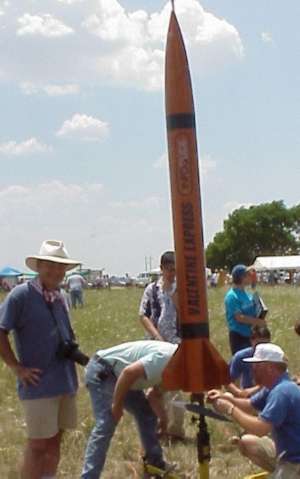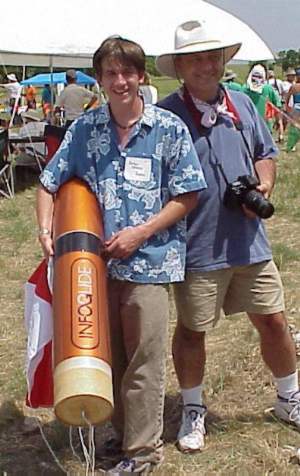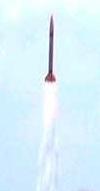Public Missiles Patriot (1/2 Scale)
Public Missiles - Patriot (1/2 Scale)
Contributed by Brian Wheeler
| Manufacturer: | Public Missiles  |

(Contributed - by Brian Wheeler)
 Brief:
Brief:
Single stage, scale, high power rocket with parachute recovery.
Construction:
One 48" phenolic body tube, a 22" phenolic payload bay, four (4) G10
fins, three (3) plywood centering rings, a 54 mm motor mount, a fiberglass nose
cone, PML's piston ejection system, two (2) 3/8" launch lugs, two (2) PML
parachute's (a 60" and a 48") and PML elastic shock chord.
The instructions were easy to follow with illustrations for every step. It was extremely easy to build, but it took TONS of epoxy. This wasn't the kit's fault, though, it's just really big. Everything fit well and there were no alignment issues. All was well thought out.
There was only one part of the instruction that I didn't understand; how the recovery was expected to be done. There were two 'chutes, the piston, and a lot of the Public Missiles elastic (which we wouldn't have used anyway). We decided it would be best to just have the rocket split at the middle to put less stress on the rocket, and come down in two pieces.
The instructions, after re-reading them, said to attach the rocket with the elastic. Here's what it said: "Tie the parachute to one end of the elastic shock chord. Repeat this step for both chutes. The larger chute and longer shock cord attach to the piston and the smaller chute and shorter shock cord attach to the eye-bolt on the payload section."
One of the most important techniques with this kit that was new to me and my dad both was the piston ejection system. Looking at it, I really didn't trust it, but it worked great, much better that I had seen any other system work.
It also taught us a better way to make fillets, -first, put the epoxy on, but then, tape down saran wrap tightly on either side of the fin or launch lug, and the you won't have to worry about it dripping down the side of your tube.
 Finishing:
Finishing:
The Rocket is absolutely enormous! It looks awesome, but the spiral groove
takes days to fill. We used some putty from Hobby Town, pretty thick stuff,
sanded, and you could still see the groove!
There were no decals to make the rocket scale, but there were directions to paint it so. It gives you the paint scheme with a main black body, red fin can and payload, and with the nose cone and lettering paint schemes. We didn't follow this paint scheme recommendations.
To finish it, we took our first shot at auto paint. Not knowing what we were getting ourselves into, we bought the $70 dollars of paint, primer, and gloss-coat, Then we saw that you must spray it on. All in all, the paint job cost us about $300, of course, most of the expensive stuff is reusable, and we now have the supplies to paint a car. We did the rocket Metallic Copper, (Base coat, Clear Coat), with two black metallic stripes. If you do use this paint (DuPont Automotive), wear a respirator with the correct cartridges, and have very good ventilation; the neighbors will get over the noise.
Construction Rating: 4 out of 5
Flight:
They only give you the smallest recommended motor, which is a J415, though on
the Public Missiles' site, it says you can use any 54mm motor aside from the
J90. We flew on a K550-10 for an awesome, roaring, perfectly straight boost.
The piston worked great, and the rocket broke apart (how we had set it up). It
said you don't need wadding, but we went ahead and put some under the piston
anyway, just to feel better. Sims put it at a little over 3000 feet, so we just
went with that.
 Recovery:
Recovery:
I liked the method of letting it break apart. It's not too tough to find these
pieces! The chutes brought it down without a scratch, getting Level Two
certification for my dad, David Wheeler. When we recovered the rocket, there
was one shroud-line torn from the chute. We will probably switch it out with a
Rocketman one next time, and attach the two pieces with some tubular nylon or
Kevlar®. The decent rate was good, but the smaller chute did loose a shroud
line, so I won't be using the PML 'chutes anymore.
The recovery system, like other PML kits, came with a piece of nylon which attached to the motor mount through the upper-most centering ring and attached the piston to the rocket. This was long enough to let the piston come out of the rocket about 2 feet. It appeared to be just a seat belt, very strong! The elastic was very long and looked very sturdy, but I've heard numerous times to throw it out and that's what I did (as mentioned above). I have no idea of how strong it is, just what others have said.
Flight Rating: 4 out of 5
Summary:
Me and my dad really enjoyed building this rocket. It is really cool to own a
rocket this big, most people don't even believe it flies, but it does, and
quite well. The Pro's of the kit are its size, quality, and building
techniques. I think I will buy many more Public Missiles kits in the future.
The Con's were few and small, but the spiral grooves, and the overall quality
of the parachutes.
Most of all, it was fun and a neat experience building a kit of this size. Though it is expensive, you don't really need to fly it that often, but it's really cool to show off, and I believe it to be more fun to have one giant K flight, that two or three I powered flights. It'll also usually get you on the launch highlights page. This rocket was the first rocket we've used auto paint on, and it looks absolutely stunning, but it's really expensive. I think it was worth it though, we must have gotten twenty compliments on the paint job alone, not to mention the awed faces looking at it. I strongly recommend this kit to anyone who has a big enough budget; you don't even need an altimeter.
Overall Rating: 4 out of 5
Other Reviews
- Public Missiles Patriot (1/2 Scale) By Mike Doyle
(by Mike Doyle - 12/20/02) Note: This is a slightly condensed version of all the information that Mike has produced for his Level 3 project. Visit his homepage to read the additional information and enjoy additional pictures. Introduction: This certification flight is scheduled to take place at the first available opportunity after an AeroTech M1315 reload motor can be obtained; ...
 |
 |
Flights
Sponsored Ads
 |
 |











